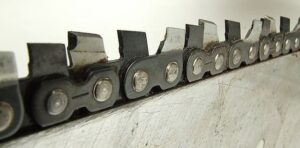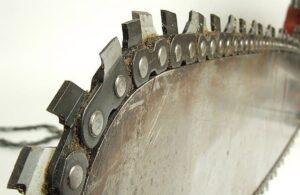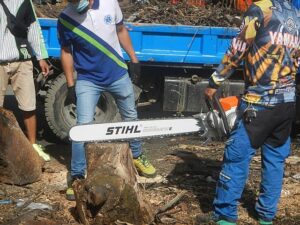As an Amazon Associate, this site earns commissions from qualifying purchases. For more information click here.
There are few things more frustrating than having to constantly adjust the chainsaw chain because it keeps coming off. This can happen for a number of reasons and fortunately, there are fixes and workarounds for it. Knowing the causes is essential for fixing it and more importantly, to make sure this does not happen again.
Chainsaw chains can come loose due to a worn out drive sprocket, a faulty chain setup or the bar has been worn out. Metal expands when temperature rises, so chains can tighten and loosen during very hot or cold weather.
In the following sections you will learn more about each possible cause and how you can fix it. Tightening a chain is not a big deal, but it does get annoying if you have to do it repeatedly. As you will see, chains that always come off could also be symptomatic of other problems.
You do not need to be an expert to troubleshoot a faulty chain. As long as you know how to use a chainsaw and familiar with its parts, you can do this.
Reason 1. Bar Heel or Rail is in Worn Out
There are two areas of the bar that can result in a loose chain, the heel and rail. Problems with either one are usually due to wear and tear.
Bar heel. The bar heel is the part that is right next to the drive sprocket. A new bar heel minimizes the amount of travel the chain has to do. As you use the chainsaw, the heel gets worn out and the distance goes up. The further the distance the chain has to go, the less stable it gets.
Bar rail. Like the chain, the bar rail is going to wear out at some point due to heavy use. Running your chainsaw at high power is only going to make this more likely. A worn out bar rail causes chain links to come loose.

Reason 2. Incorrect Chain Tension Setup
An improperly set chain tension is one of the most likely reasons. By adjusting the tension, you fix the position of the bar so the chain does not come off.
Some chainsaws including the WORX WG322 have an automatic tension feature, but others require adjusting a couple of bolts. If the bolt is not tight enough, the bar will start moving around and cause the chain to shift. You have to tighten the bolts and ensue the bar is set and fixed in the right position. The chain tension cannot be too loose or too tight. It has to be just right.
Do not use a chainsaw if the chain is not properly configured. This can lead to performance issues or even put you at risk. Always check the chain before attempting any sort of heavy duty cutting job.
Reason 3. Drive Sprocket Needs Replacement
The drive sprocket drives the blade around the chainsaw bar, so it is one of the most important parts. Because it plays such a vital role, drive sprockets are subject to wear and tear. It has to keep the blade in the right position and maintain its force. If this fails the chain will come off. Unlike other parts, this one is better off being replaced rather than try to repair it.
The best solution is to replace the drive sprocket. These are built for heavy use so when it gets worn out, it is a clear signal a replacement is needed. In the following video you will see how a sprocket is replaced.
Reason 4. Hardware Failure
If the chain is always coming off, there could be an internal problem. To be specific, it has something to do with the chain tension.
When you set the chain tension tight, the system moves the sprocket and bar apart. At least that is how it is supposed to be in a working chainsaw.
If the hardware is damaged the chain will come off. No amount of adjustment is going to fix this as it will need repair. Unless you are an expert in fixing this, take your chainsaw to the repair and have a specialist look into it. This is why it pays to invest in a quality product. The Makita XCU03PT1 14 inch chainsaw for instance, is built for long term use.
Chainsaws are made up of many parts so it is better to let an expert look into it. Whether it is gas, electric or battery, damage to any component will affect its performance.
Reason 5. Temperature Changes
This has nothing to do with the chainsaw but with how science works. Metals expand when the temperature rises and contracts when it cools. You will notice this if you use a chainsaw in hot and cold climates.
If you set the chain tension during a warm sunny day, it will be a perfect fit. You use the chainsaw and it runs well. But if you run that chainsaw in wet conditions the chain is going to come loose.
The opposite happens if you set the chain in cold weather. It will work fine but when the temperature rises, the metal will expand and cause the chain to tighten up.
In this case there is nothing wrong with your chainsaw and you just have to keep making adjustments. This will only be an issue if it gets hot and then cold in your area.
Chain contraction and expansion only happens when the temperature change is significant. Unless you work in varying climates, this should not be a major issue.
How to Tighten a Chainsaw Chain
The first thing you have to do is check if the chain is too loose, too tight or just right. Lift the chain off the bar. If the chain comes up quickly, it needs to be tightened.
If you pull the chain off the bar and see a bit of space, the tension is right and no adjustment needed. If you fit a quarter in the gap, that is good. If it cannot fit, the chain is too tight. Now if the space is too big, the chain is too loose.
To fix loose chain tension, follow these steps. Use the wrench that came with your chainsaw to make the adjustment.
Step 1. Loose the guide bar and chain. If the brake is connected to either or both, detach it with the screw wrench.
Step 2. Once the side panel is off you can adjust the tension screw. If you loosen the tension, the chain loosens. If you tighten the tension, the chain gets tight too.
Step 3. Once you are satisfied with the tension level, tighten the nuts and guide bar. Raise the nose so you can verify the tension is evenly distributed.
Test the chainsaw and let it warm up. The chain should run smoothly now, not too loose and not too tight.
But what if you followed these steps and the chain still comes off? In that case you have to do a bit of troubleshooting to fix it.
Troubleshooting Chains That Keep Coming Off
The first thing you should do is inspect the links, bar rail, grooves and bar heel. If any of them are worn out you have to replace it.
There are other things you can check if the chain keeps getting loose
Wrong chain size. The chain has to be the exact size, otherwise the chainsaw will not work. You might be able to install it but the chain will not fit correctly.
Take out a chain link. Sometimes removing a chain link works. Look for the master link (this should be stated in the product manual) and use a screwdriver to open it. Take the end link and check if the chain tightens. You may need to remove a few more links to get the adjustment right.
Tension adjustment screw does not work. The most likely reason is that it is stripped. Without a functioning tension adjustment screw you will not be able to tweak the chain setting, so it has to be replaced.
Guide bar problems. If you have to replace the bar heel or rail, make sure it is the right size. Measure the bar so the replacement will be a good fit.
Replace the chain. Chainsaw chains will last a long time, but at some point it will need to be replaced.
There are many types of chains so make sure you buy one that is the right size. Check your chainsaw manual for the proper type of chain to get.
Are Loose Chainsaw Chains Dangerous?
Ill-fitting chains carry a risk because it can fly off anytime. If you are cutting wood at high power and the blade comes off, you could get seriously hurt. That is why you should never use a chain if it does not fit properly.
In many cases a simple workaround like the ones in this post will fix the problem. But you should always keep an eye on the chain. Always inspect the chain before you use it. If you notice anything amiss, stop immediately and turn it off. You should only try the fixes here when the chainsaw is turned off.

I love the outdoors and all the tools for maintaining gardens, yards and lawns. The only thing I am more passionate about is sharing what I know about garden and outdoor equipment.


